
|
"Dore Lake has one of the greatest long-term potentials for recreation development of all the lakes in the commercial forest area. The reason for this are simply that Dore Lake is a very large lake and is not too distant from developed areas, and is very highly productive of angling species. In addition, it has pleasant surroundings of excellent forest site."
H.G. Young, Director of Conservation, 1956

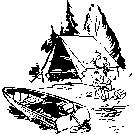
By the mid 1950's, the tourist population in Dore Lake was beginning to grow at a rapid pace. In 1951, D.N.R. progress reports, showed that Lac La Plonge, was not producing the quantity of fish it had in the past. Many unsuccessful anglers on their return trip home from La Plonge, were dropping in on Dore Lake to test the fishing. Enthusiastic anglers were obtaining good results and began returning to Dore every year for more fishing. The D.N.R. decided that facilities were needed to accommodate these tourists. Therefore in 1956, a camp kitchen and two toilets were established at Husak's Bay. During this period, many people had been contacting the Department of Natural Resources and inquiring about purchasing land to build summer cabins and homes on the Lake. With the influx of tourists and their demands for recreational facilities, the government soon realized the areas economic potential and decided to develop the tourist industry. In 1957, the Department of Forestry, went to Dore Lake to look for suitable beach areas that could be developed. The East side of Michel Point was considered a good place to develop a beach. It was recommended that a road be built to Michel, to aid in the development of the tourist industry. The Department of Forestry proposed that a couple of sub-divisions be surveyed that spring. The land was surveyed and three lodges were soon erected in the Michel Point area of Dore Lake. Mr. Carmen Jones of Meadow lake, erected Michel Lodge in 1957, Wilfred Joncas, constructed Tower Sub-division in 1958 and Camp Carmel was established in the spring of 1962. In 1957, R.W. and B.W. Fellows of Shellbrook, received a lease to erect and maintain, four to six cabins for commercial purposes, adjacent to the shore of Dore Lake on Husak Bay. Here is their story. The account of the four individuals, who pioneered the tourist industry in Dore Lake. They recognized Dore Lake's potential as being a tourist's delight. It was easily accessible; only one hundred and fifty miles north of the nearest city. It was the north-south boundary of Saskatchewan's wilderness land. It offered some of Saskatchewan's prime hunting and fishing grounds. But most of all, it offered a pleasant, beautiful environment, that has brought peace of mind to many.
Tower Sub-Division - Wilfred Delor Joncas.
By Opan Joncas Swedberg. 
July 1959, First Cabin built by Del Joncas.
One of the first residents of Tower Sub-Division, other than the resident towerman, was "Del" Joncas. He established here in 1958. In 1959, we, my husband Glenn, daughter Glenda and myself, made our first trip to Dore Lake. This was a major event in itself. There was no all-weather road and travelling was done in convoy style. The first vehicle revved up its motor and speeded through the mud hole. If successful, then the next in line tried the same strategy. If not then, out the axes came and a corduroy road was practically constructed on the site. If you were travelling alone and ran into trouble, you just sat and waited for the patrol to come along, or another vehicle to give you a push or pull. Our cabin was constructed in 1960. A unique feature at our sub-division is that everyone who resides here now, came by word of mouth. Friends of ours built and friends of their's in turn, which makes for a closely knit community. In 1963, Del purchased a piece of commercial property and started constructing a motel; six units in all. Unfortunately, it was destroyed by fire in June, 1965. In November of 1965, while working in the Big River Theatre, Del had an accident and severely injured his back. After five months recovery, Del's plans to re-build the Lodge were underway. On April 30, 1965, Verner Johnson went over to the Tower across the ice. He was on his way to town and checked to see whether Del needed any supplies. That night when he came through, there was no light in the cabin and he thought he wouldn't wake Del. He came back early next morning to drop off the supplies and found Del had passed away peacefully in bed. We all felt that the Lodge should be reconstructed. My husband Glenn, with the help of friends and relatives, took out the hammers and started pounding. Three cabins were built on the former site of the motel. We often recall the different type of customers we have had over the years. Generally, they all seem to ask for ice cream and hot and cold running water. We were generating our electricity at the time. They were told if they wanted hot running water it depended on the time it would take them to grab the water pail, run down to the Lake, fill it up and get back to the cabin. This always brought a smile to their faces. You see many a strange sight in this business. The funniest, was the moose hunter who got into a boat, opened an umbrella, and shielded himself from the wind. At this point in time, there are twelve cabin owners in our sub-division. After the first four cabins were constructed, we were joined by the Nelson's, Murphys, Haughns, Smiths and Rylands, Muzichuk, Farenick and Zinovich. We have formed an association and at present, all cabins have been serviced with holding tanks, sewer and water. A first on the Lake. 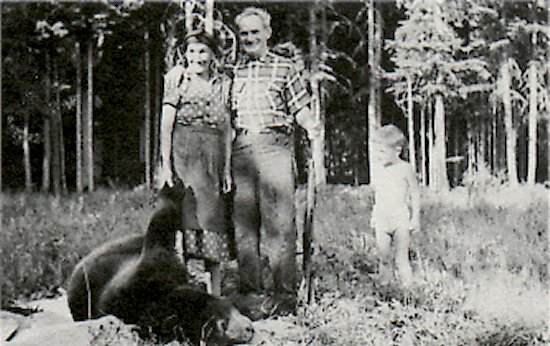
August, 1961. Mary McBride (left), Del Joncas (center)
and Brian Craig (right), with black bear. 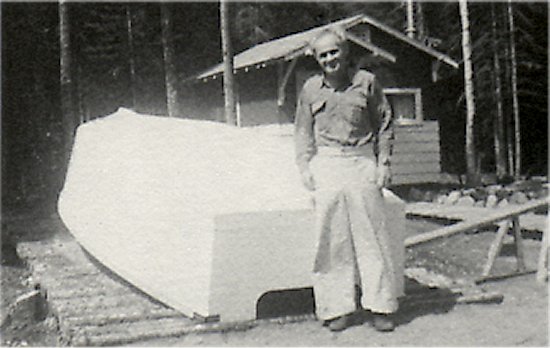
Del Joncas building a boat, 1961.

Del Joncas after the fire, June, 1965.
Michel Lodge.
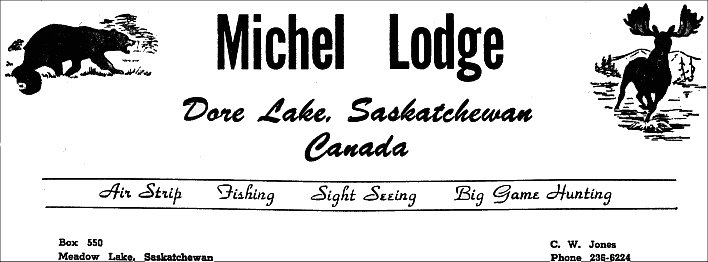
Michel Lodge Logo.
I built the Lodge in 1957, the year the road was extended to Michel Point. We ferried all our material for the first four cabin units, across the lake from South Bay. The day the road opened, some people drove in and rented a cabin. We had no beds in yet, but they had their own bedding and slept on the floor. Arthur Anderson was my first operator, who supervised the building. Peter Weems was the carpenter. Both of these men were from Meadow Lake. Other operators of the Lodge were; my son and his wife, Ken and Carol Jones, Lem Moore of Meadow Lake, who is now deceased and Gerald Jones, my son. I was one of the first operators to start a fly-in moose hunting camp. One peak season we flew fifty-four hunters in two Cessna 180's, into the bush. These hunters shot forty-nine moose. Presently Michel Lodge is owned and operated by Brian and Aleta Cornish. 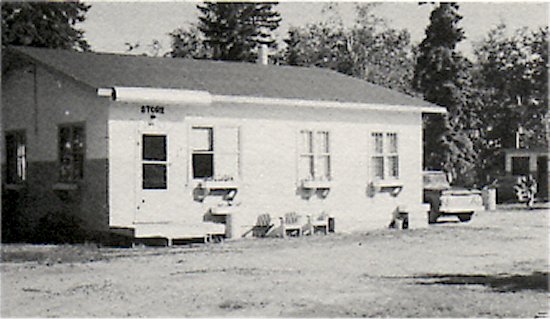
Michel Lodge, 1974.
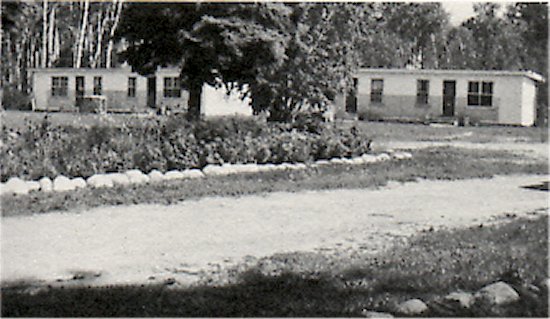
Michel Lodge, 1974.
Dore Lake Lodge, by Vera Bishop.

Dore Lake Lodge.
Bert Fellows had been fishing at Dore Lake and found the fishing to be excellent. Bert and Ralph Fellows and my husband, George, and I, discussed the potential of a lodge business at Dore Lake. In 1957, a lease was granted for the construction of a lodge. (Originally, Len Waite of Big River had applied for this site. Mr. Waite had obtained funds from the Construction Branch of the Northern Region, and bulldozed one half mile of road out in this area. He intended to move four of his buildings, which were located near D.N.R. headquarters (at D.N.R. Point), to this new site. However, Mr. Waite decided to sell these four buildings to Mr. Fellows and relinquish the plans for a lease.) Ralph and two of our boys, Billie and Ralph Bishop spent the winter of 1957 clearing a camp site. The four buildings purchased from Waite Fisheries were moved across South bay over the ice. These were renovated into cabins and a store. All equipment, furnishings etc., were brought across from Harry Husak's by boat. Our first customers were also brought over by boat. There was no road into the Lodge, so Mr. Viden Sr. used his cat to bulldoze a road through. We managed to bring in a small light plant by tractor. Many cords of logs were used to corduroy swamps before any vehicles could use the road. We started with three cabins and three boats. The following winter three more boats were built, and much time was spent logging and packing ice for tourists. The following spring, Mr. Viden Sr. sawed our lumber. Two more cabins were built during the summer of 1959 and four more in 1960, which gave us nine cabins and by that time we had eleven, twenty foot boats. In the summer of 1963, we built a new store, which also contained a lunch counter and living quarters. We also had a walk-in deep freeze, which allowed us to freeze tourist's fish along with meats, for the store. Many a trip was made in rough water searching for parties, which hadn't returned to camp. We had two light plants, which required a tremendous amount of maintenance. Power was on for twenty-four hours a day. The D.N.R., Mr. Viden Sr., and Dore Lake Lodge, cleared and prepared a landing strip for airplanes, which is still being used. Building a dock was an annual job, as spring break-up would push it up on shore. After battling with that for many years, we built a log cribbing and filled it with tons of rock for a breakwater. This dock lasted for many years and was in use up to 1979. Bill and Mildred, remained with us until their eldest daughter was of school age. Twins were also born to them while with us at Dore. They moved to Shellbrook, where Billie was employed at Auto Body. We had many employees over the years. Without their help we would not have been able to carry on. Help was always available across the Bay, when additional help was needed. In the fall of 1972, just at the close of the early moose hunting season, George suffered a heart attack, which necessitated our selling the Lodge to Alex Shukun and moving to Shellbrook. We spent fifteen very happy years at Dore Lake and have many happy memories and unforgettable tourist friends, who visited us over the years. The first summer we were there, bears would go through the camp every night, upsetting the garbage cans. We were wakened early one morning by a noise on the roof. George went to investigate and found a cub boxing the stove pipe. When the bear heard the door, he was in such a rush to get down, and fell off the roof. 
Dore Lake Lodge
Camp Carmel, by Bernard Palmer
Camp Carmel was born in the conversion of one of its founders, a former alcoholic who loved to fish and hunt. He began to long for a place where those sports could be carried out in a Christian manner and atmosphere. Camp Carmel is the result. In the spring of 1962, Marshall Calverley, a missionary with the Northern Canada Evangelical Mission, was visiting in Nebraska. As he visited with Bernard Palmer, they expressed concern for Palmer's brother, LaVern. His cabin on a small Nebraska Lake was surrounded by his former drinking buddies who were no longer his best friends. Jerry Dunn, of Omaha, Nebraska, was visiting LaVern at the time, so as the four men gathered over coffee, the possibility of a Christian Camp in Canada was discussed. They began to get excited about the idea and formed a group to expedite it. They asked Marshall Calverley, who was a pilot and also acquainted with the Northland, to select a likely spot. By June of that year both Palmer brothers had sold their cabins, and Marshall Calverley had leased a spot on Dore Lake for Camp Carmel. Marshall and his son, Ron, built the first three cabins that spring and the Palmers came North. The next spring, another two cabins were built and at later dates four others were erected until now there are nine privately owned cabins at Camp Carmel. Since 1962, the Bernard Palmers have continued to spend their summers from late May until early September at Dore Lake. LaVern Palmer spent a good deal of time there also, because he had poor health and was unable to work. He continued as his health permitted and when he could no longer come, he finally sold his cabin. Because there were no religious services, the two Palmer families, along with whoever else was at camp, began to have informal services or Bible Studies in their cabins on Sunday mornings. Eventually, other campers in the area, who were regular church goers, heard about it and began to come for the studies. Because there were no other services in the Dore Lake area at that time, the Cabin owners began to see that if they had a building, they could open the services to anyone who would like to join them in worship. In 1973, the camp built Camp Carmel Hall, all with the help of volunteer labour and the aid of donated funds from those who wished to help. That same summer, Ken Anderson Film Company of Warsaw, Indiana, filmed a youth film entitled "Silent Thunder", with a great deal of co-operation from the people who lived at Dore Lake. )He later filmed another youth film on Dore Lake entitled, "Little Eagle".) Sensing a need, Mr. Anderson volunteered to supply his film library for Sunday evening viewing. The people in the area responded by their attendance, and since then, Christian films have been shown every Sunday evening. Campers and townsite dwellers have come, as well as local people as well as local people and a heart-warming relationship has developed. The purpose of Camp Carmel from its beginning has been more than the superb fishing spot it is. It has been a place of rest and relaxation and spiritually refreshing for many Canadians and Americans alike. Friends have brought other friends and visitors have made long-lasting friendships. There has been family reunions and other gatherings, which seem to make each visitor anxious for another time when they can come back to Camp Carmel. Camp Carmel's is grateful to be included on the shores of the beautiful Dore Lake. It is thankful for the Canadian old-time manner of helping a fellow when he needs help, and is happy when the camp can be of service to others. Camp Carmel's motto is, COME YE APART AND REST AWHILE. The clear, pure air has rejuvenated many a restless heart. The beauty of the lake and trees, cause many to thank our great God who created it. And the fellowship Canadians and Americans have had together, fills our lives. Yes, we can truly say, God has picked this place for Camp Carmel. 
Outdoor Service at Camp Carmel.
|
| Deep River Fur Farm |
| Deep River Trapping Page |
| Deep River Fishing Page |
| My Norwegian Roots |
| Early Mink People Canada - Bowness |
| The Manager's Tale - Hugh Ross |
| Sakitawak Bi-Centennial - 200 Yrs. |
| Lost Land of the Caribou - Ed Theriau |
| The History of Buffalo Narrows |
| Hugh (Lefty) McLeod, Bush Pilot |
| George Greening, Bush Pilot |
| Timber Trails - History of Big River |
| Joe Anstett, Trapper |
| Bill Windrum, Bush Pilot |
| Face the North Wind - Art Karas |
| North to Cree Lake - Art Karas |
| Look at the Past - History Dore Lake |
| George Abbott Family History |
| These Are The Prairies |
| William A. A. Jay, Trapper |
| John Hedlund, Trapper |
| Deep River Photo Gallery |
| Cyril Mahoney, Trapper |
| Saskatchewan Pictorial History |
| Who's Who in furs - 1956 |
| Century in the Making - Big River |
| Wings Beyond Road's End |
| The Northern Trapper, 1923 |
| My Various Links Page |
| Ron Clancy, Author |
| Roman Catholic Church - 1849 |
| Frontier Characters - Ron Clancy |
| Northern Trader - Ron Clancy |
| Various Deep River Videos |
| How the Indians Used the Birch |
| Mink and Fish - Buffalo Narrows |
| Gold and Other Stories - Richards |
